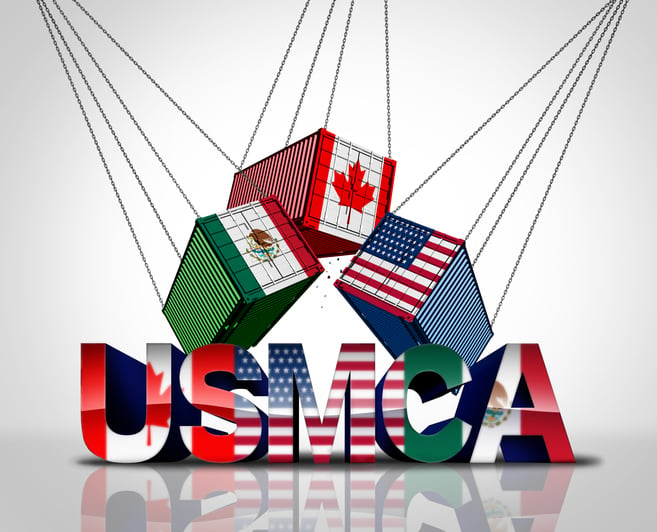When it comes to deciding between Mexico vs China manufacturing, businesses are faced with a challenging decision. The trade volume between the United States and Mexico has been on the rise, as companies seek to mitigate disruptions and address geo-political risk that can affect their supply chains. Mexico's proximity to the United States provides certain supply chain advantages over China, making it an attractive option for companies looking to optimize their manufacturing operations. However, when comparing Mexico vs China manufacturing, it is crucial to consider factors beyond just production costs, such as total landed costs. In this article, we will explore one of the key considerations and factors that businesses should take into account when choosing between Mexico vs China Manufacturing. In this article, we will be discussing the general differences between shipping from suppliers in China to the US versus shipping from suppliers in Mexico. We will cover transit modes, transit times, and costs.
Comparing the Modes of Transportation when Shipping from China vs Mexico to the US
When comparing the modes of transportation for shipping from China vs Mexico to the US, companies can save significantly by opting for Mexico. When it comes to shipping from China, companies can choose between ocean freight and air freight.
China’s Transportation and Port Infrastructure: Backbone of Global Export
China’s status as a global manufacturing powerhouse is closely tied to its extensive and modern transportation network. Over the past few decades, the country has invested heavily in developing an interconnected system of highways, rail lines, and world-class ports—all designed to keep the wheels of international trade turning smoothly.
Major cities like Shanghai, Shenzhen, and Guangzhou host some of the busiest and most advanced ports in the world. These ports are equipped for high-volume, high-efficiency container handling, allowing businesses to move goods quickly and reliably to markets across the globe. The reach doesn't stop there: China’s well-established rail and road networks ensure products can be efficiently transported from inland factories to coastal shipping hubs with minimal delays.
While shipping goods from China to North America generally involves longer distances—and, by extension, longer transit times—Chinese ports are renowned for their reliability and capacity. This extensive logistics infrastructure helps manufacturers maintain steady export flows, even at massive scales, thanks to streamlined processes and robust global connections.
Mexico's proximity to the US and its connections with the North American transportation systems make it an advantageous location for manufacturing industries looking to access the US market. Mexico offers various transportation modes such as over-the-road trucking, rail, ocean, and air, making it a convenient choice for shipping to the US.
Comparing Transit Times when Shipping from China vs Mexico to the US
When comparing transit times for shipping from China versus Mexico to the US, it is obvious that shipping time from Mexico to the US is significantly shorter compared to shipping from China due to the proximity of Mexico to the US market.
Shipping time from China to USA
Typical transit times from Shanghai to the five largest cities in the US vary based on shipping methods and logistical factors. Generally, for ocean freight, shipments from Shanghai to Los Angeles can take around 15-20 days, while transit times to New York City may range from 25 to 30 days. Chicago typically sees transit times of approximately 20-25 days, while shipments to Houston and Phoenix may take around 25-30 days.
However, these estimates are subject to change based on factors such as port congestion, weather conditions, Panama Canal traffic, railroad delays and the specific shipping route chosen. Therefore, companies must factor in these variables when planning their supply chain and logistics operations to ensure timely delivery of goods.
Shipping time from Mexico to USA
Typical transit times from Mexico to US cities can vary depending on transportation modes and logistical considerations. Generally, for over-the-road trucking, shipments from Mexico City to Dallas can take approximately 2-3 days, while transit times to New York City may range from 4 to 5 days. However, these estimates are subject to factors, such as border processing times, road conditions, and customs clearance procedures. Below is a table that shows typical transit times between some key cities in Mexico and the United States.
Shipping Container Sizes from Mexico and China
When comparing international shipping from China and Mexico to the US, the differences in container sizes between China and Mexico present distinct logistical considerations. Ocean containers from China are typically standardized at 20 Feet, 40 feet, or 40 feet High Cube (HQ).
Conversely, trailers and rail containers commonly used in Mexico and the United States are longer, measuring 53 feet. This variance in trailer and container dimensions holds crucial implications for cargo capacity and costs per unit. Notably, goods transported on trailers from Mexico benefit from the larger container size, allowing up to 50% more items to be carried compared to shipments from China.
This advantage becomes particularly pronounced when shipments don't reach maximum weight capacity, optimizing space utilization and enhancing cost-effectiveness for businesses engaged in cross-border trade.
Shipping Costs Comparisons: Mexico vs China
In this section we will be comparing Ocean freight versus cross border logistics using full truckload (FTL) to transport goods. It is important to remember when comparing shipping costs, it's crucial to consider the freight cost per unit in relation to the actual price of the shipment.
As we stated above, fullsize steamship containers are 40' in length and a 53' trailer from Mexico would hold up to 50% more volume if under the legal highway weight limits. If a container from China costs $5,000 and a truck from Mexico also costs $5,000, importers could effectively lower their shipping costs by 33% using a 53' trailer from Mexico.
How much does shipping from China to US cost?
Ocean container pricing operates within a complex framework influenced by various factors. Typically, pricing is determined by shipping volume, container size, route, shipping company, fuel costs, demand, and market conditions. As stated above, container sizes commonly used in international shipping include 20-foot and 40-foot containers, with the latter being the most prevalent.
Shipping companies offer different pricing structures, including spot rates and contract rates. Spot rates fluctuate based on market conditions and are typically higher but offer flexibility for shippers. Contract rates, on the other hand, are negotiated agreements between the shipping company and the shipper for a specified volume and duration, often providing stability and potentially lower rates. However, contract rates also have penalties if the volume agreements are not met.
Surcharges such as fuel surcharges, peak season surcharges, and currency adjustment factors may apply, adding to the overall cost. The competitiveness of the shipping market, geopolitical events, and regulatory changes can also impact pricing dynamics.
During the COVID-19 pandemic, the average container prices experienced a remarkable surge, reflecting the profound disruptions in global trade and logistics. The outbreak led to widespread lockdowns, port closures, labor shortages, and disruptions in supply chains worldwide. As a result, demand for shipping containers surged, driven by a combination of factors such as increased e-commerce activity, stockpiling of essential goods, and a surge in demand for medical supplies.
There were significant disruptions in container availability, with many containers stranded at ports or in transit due to logistical bottlenecks. The imbalance between supply and demand caused container prices to skyrocket, reaching unprecedented levels with many companies i the US paying over $20,000 per container. Shipping companies and freight forwarders faced immense pressure as they struggled to meet the surging demand while grappling with soaring container prices, exacerbating the challenges faced by businesses reliant on international trade.
Ocean freight rates returned to near pre-2020 rates but recently with conflict in the Middle East and the push to get manufacturing orders shipped before the Chinese New Year in 2024, the ocean freight industry witnessed another significant jump in container rates, compounding the challenges already posed by the COVID-19 pandemic. The conflict in the Middle East led to heightened geopolitical tensions and disruptions in key shipping lanes, affecting the smooth flow of maritime trade.
At the same time, the drought in the Panama Canal resulted in restrictions on vessel drafts, limiting the passage of larger ships and necessitating alternative routing for ocean freight. These combined factors created bottlenecks and delays in global supply chains, exacerbating existing container shortages and driving up container rates to new levels not seen since late 2022. As shipping companies navigated through these tumultuous waters, businesses faced heightened uncertainty and escalating costs, underscoring the vulnerability of global trade to geopolitical and environmental disruptions.
One issue that could also impact ocean pricing is the potential conflict between China and Taiwan. If China were to invade Taiwan, it would likely trigger significant disruptions and uncertainties in global trade, with profound implications for ocean pricing and maritime shipping schedules.
Such a scenario could lead to heightened geopolitical tensions, potentially resulting in the imposition of trade sanctions, embargoes, or other measures that could disrupt maritime trade routes and supply chains. The uncertainty and risk associated with a military conflict in the Taiwan Strait could lead to increased insurance premiums for vessels transiting the region, further adding to shipping costs.
Additionally, the possibility of supply chain disruptions, port closures, and increased transit times due to heightened security measures could lead to a tightening of vessel capacity and a surge in demand for shipping services. As a result, ocean pricing is likely to see a significant spike, driven by increased freight rates, surcharges, and other related costs as shipping companies seek to mitigate risks and adapt to changing market conditions amidst the geopolitical turmoil assuming any ocean freight was allowed through the Taiwan Strait.
Thankfully, this has not occurred as of this writing and today, a 40' container from China can cost anywhere from ~$4,000 - $8,000 delivered when evaluating origin and destination locations, port fees, chassis rentals, and other fees applied for clearing customs. Obviously, warehouses near the ports will be significantly lower than shipping to the inland of the United States.
This cost range does not include any tariffs that may be applied to the goods or detention and demurrage charges that often happen with steamship containers.
How much does shipping cost from Mexico to US?
The cost of shipping from Mexico to the US can vary depending on several factors including the weight and dimensions of the shipment, the shipping method chosen (air, sea, or ground), and the urgency of delivery. Other factors such as customs duties, taxes, and insurance can also contribute to the overall cost of shipping.
But, if looking at full truckload shipping to compare against Ocean Containers from China, the key drivers for cost are the distance between the origin and destination and the supply and demand for equipment in the given origin and destination areas.
For example, manufacturing in Tijuana and shipping to San Diego will typically cost $350 for a truckload for a ~20 mile journey. Monterrey, MX to the Dallas-Fort Worth area costs in the $2600 - $2800 range. While shipping from Guadalajara in the state of Jalisco, Mexico to the state of New York can cost upwards of $9,000. So, as you can see the prices vary greatly.
The key thing to consider is that logistics costs have a significant impact on total landed costs for a product.
The Impact of Shorter Transit Times on Supply Chains
Manufacturing in Mexico can revolutionize supply chains, yielding significant benefits. By relocating production facilities closer to the U.S., companies can drastically reduce inventory levels. This proximity enables a more agile response to demand fluctuations, minimizing the need for excess stockpiling. Moreover, shortened distances lead to faster transportation times, enhancing planning cycles and allowing for more accurate forecasting. As a result, companies can optimize their production schedules, efficiently meeting market demands while minimizing overproduction.
Additionally, this streamlined approach translates into improved cash flow management, as capital is no longer tied up in excessive inventory or lengthy transit times. Moreover, when comparing the financial aspects of manufacturing in Mexico versus China, companies are looking at substantial savings: approximately 4% in energy costs, 60% in natural gas costs, and 40% in lease rates. These figures underscore the lower overhead and transportation costs, making Mexico an increasingly attractive option for manufacturers seeking efficiency and cost-effectiveness.
Overall, the strategic shift toward closer manufacturing promises not just cost efficiencies but also resilience and adaptability in an ever-evolving global marketplace. By integrating specific cost comparisons, the benefits of manufacturing in Mexico become even more compelling, offering clear financial advantages alongside strategic supply chain improvements.
Ideal Markets and Industries for Manufacturing in Mexico
For companies aiming to access the North American market quickly and cost-effectively, Mexico stands out as a top manufacturing location. Industries that benefit the most from Mexico’s proximity, competitive labor rates, and streamlined trade facilitated by agreements like the USMCA include automotive, aerospace, electronics, appliances, and medical devices.
Manufacturers serving sectors with tight timelines—such as automotive manufacturers supplying to Detroit or aerospace firms working with Boeing or Bombardier—gain a significant edge by reducing shipping times and import complexities. Similarly, consumer electronics and appliance brands looking to replenish U.S. retail shelves quickly can leverage Mexico’s location for shorter lead times and inventory flexibility.
Overall, Mexico’s strengths align best with industries that require speed to market, frequent cross-border logistics, and compliance with North American standards—making it a smart choice for companies prioritizing both cost efficiency and regional agility.
How Work Culture and Management Practices Influence Manufacturing Efficiency in Mexico vs China
When comparing manufacturing efficiency between Mexico and China, it's impossible to ignore the major role played by work culture and management styles. These aspects shape not only daily operations, but the overall productivity equations that define both countries’ reputations on the global stage.
In Mexico, there's a marked trend toward integrating North American management styles, thanks in part to strong trade relationships and agreements like the USMCA. Many factories are emphasizing collaborative management, with decision-making that relies on clear communication between leaders and shop floor teams. This approach fosters a work environment where employees are empowered to offer feedback, take initiative, and adapt quickly to production adjustments. As a result, Mexican facilities—bolstered by a youthful, increasingly skilled labor force and advances in automation—are seeing steady gains in output, especially in key sectors like automotive and electronics.
However, the efficiency boost isn’t uniform across the country. Regions with strong infrastructure and investment in technical training tend to see higher productivity rates, while more remote areas can lag behind due to limited resources or older operational practices.
China, on the other hand, is known for a different flavor of manufacturing culture: one marked by rigorous discipline, rapid adaptation, and adherence to tight schedules. State-led initiatives have funneled significant investment into robotics, AI, and other productivity enhancers. Managers often drive employees hard to meet both domestic and global demand, with long hours and a strong focus on process optimization. This intense work ethic contributes to China’s reputation for speed and efficiency, but it comes at the cost of worker fatigue and occasional burnout—something factories are working to balance as global labor standards and expectations evolve.
In short, while both countries are making strides in workforce development and the adoption of advanced technologies, the human element—how teams are led and how workers are treated—remains a key differentiator. Manufacturers evaluating Mexico or China as a potential base need to consider not only wages and overhead, but whether the prevailing management practices and cultural dynamics align with their operational goals. This perspective is essential for ensuring lasting efficiency gains, resilience, and sustainable growth in today’s competitive manufacturing landscape.
Tariff Impacts on Total Landed Costs: Mexico vs China Manufacturing
When evaluating the total landed costs between Mexico and China manufacturing, tariffs represent one of the most significant and volatile cost factors that can dramatically shift the economic equation. Under the current Trump administration's trade policies, the tariff landscape has fundamentally altered the competitive dynamics between these two manufacturing hubs.
Current Tariff Environment
China Tariff Structure: The United States maintains substantial tariffs on Chinese imports, with rates varying significantly by product category. Many manufactured goods from China face base tariffs ranging from 7.4% to 25%, with some strategic sectors experiencing even higher rates. However, the Trump administration has implemented "reciprocal tariffs" through emergency powers, adding an additional 10% to traditional tariff rates for most countries, including China. This means Chinese imports now face effective tariff rates of 17.4% to 35% or higher, dramatically increasing the cost burden on businesses importing from China.
Mexico's Tariff Advantage: In stark contrast, Mexico benefits from preferential trade access through the United States-Mexico-Canada Agreement (USMCA), which exempts Mexican imports from the additional 10% reciprocal tariff. Most manufactured goods imported from Mexico continue to enter the U.S. duty-free or with minimal tariff rates, typically ranging from 0% to 2.5% for qualifying products. This exemption creates an even more substantial cost advantage that directly impacts the bottom line of total landed costs.
Quantifying the Tariff Impact
To illustrate the financial impact, consider a product with a $10,000 manufacturing cost:
China Scenario:
- Manufacturing Cost: $10,000
- Ocean Freight: $6,000
- Base Tariff (15%): $1,500
- Reciprocal Tariff (10%): $1,000
- Total with Tariffs: $18,500
Mexico Scenario:
- Manufacturing Cost: $10,500 (slightly higher labor cost)
- Trucking: $3,000
- Tariff (0% under USMCA): $0
- Total with Tariff: $13,500
In this example, despite Mexico's slightly higher manufacturing costs, the total landed cost is $5,000 lower due to tariff savings and reduced transportation costs. The reciprocal tariff alone adds $1,000 to the Chinese option.
Strategic Considerations for Tariff Planning
Tariff Volatility and Risk Management: Tariffs on Chinese goods have proven highly volatile, changing based on trade negotiations, geopolitical tensions, and economic policies. This uncertainty makes long-term cost planning challenging and introduces significant financial risk for businesses relying on Chinese suppliers. Companies must factor in potential tariff increases that could occur with little advance notice.
USMCA Stability and 2026 Renegotiation: Mexico's tariff advantages are currently codified in the USMCA agreement, providing greater predictability and stability for business planning. However, the Trump administration has announced plans to renegotiate USMCA in 2026, introducing potential uncertainty into Mexico's long-term tariff advantages. While this creates some planning considerations, the current treaty-based protection still offers companies more confidence in their cost projections through 2026 compared to the volatile tariff environment facing Chinese imports.
Emergency Powers and Reciprocal Tariffs: The implementation of reciprocal tariffs through emergency powers demonstrates the administration's willingness to use executive authority to rapidly adjust trade costs. This policy tool affects all non-USMCA countries, creating an additional 10% cost burden that can be implemented with minimal advance notice, further emphasizing the value of Mexico's protected status.
Product-Specific Tariff Analysis: Different product categories face varying tariff rates. Electronics, textiles, and industrial machinery often face higher Chinese tariffs, while automotive components and medical devices may have different rate structures. Businesses must conduct product-specific tariff analysis to understand their unique cost implications.
Beyond Basic Tariff Rates: Additional Trade Costs
Anti-Dumping and Countervailing Duties: Some Chinese products face additional anti-dumping or countervailing duties on top of standard tariffs, potentially adding another 10-50% to import costs. These additional duties are product-specific and can significantly impact total landed costs for affected categories.
Section 232 and 301 Tariffs: Specialized tariff programs targeting specific sectors or trade practices can result in additional costs for Chinese imports. These programs often carry higher rates and may apply to broad categories of manufactured goods.
Customs Processing Differences: Shipments from China often face more intensive customs scrutiny, potentially leading to delays and additional inspection fees. Mexico's proximity and USMCA benefits typically result in smoother customs processing and lower administrative costs.
Impact on Supply Chain Strategy
Inventory and Cash Flow Implications: Higher tariffs on Chinese goods increase working capital requirements, as companies must account for additional duty payments in their cash flow planning. The tariff differential between China and Mexico can free up significant working capital when manufacturing shifts to Mexico.
Competitive Positioning: Companies that successfully leverage Mexico's tariff advantages can achieve better pricing in the U.S. market, potentially gaining competitive advantages over competitors still relying on higher-tariff Chinese manufacturing.
Long-term Planning Considerations: The tariff environment should be evaluated not just on current rates but on potential future changes. Mexico's treaty-protected status provides more stability through 2026, though the planned USMCA renegotiation introduces some uncertainty beyond that timeframe. Chinese tariff rates remain subject to immediate changes through emergency powers and ongoing political and economic developments, including the potential for additional reciprocal tariff increases.
Recommendations for Manufacturers
When evaluating total landed costs, manufacturers should:
- Conduct Regular Tariff Reviews: Stay updated on current tariff rates for specific product categories and monitor proposed changes.
- Model Different Scenarios: Calculate total landed costs under various tariff scenarios to understand potential risks and opportunities.
- Consider Tariff Escalation: Factor in the possibility of tariff increases when making long-term sourcing decisions.
- Evaluate Duty-Free Programs: Ensure full utilization of available duty-free programs and trade agreements.
- Integrate Tariff Costs into ROI Analysis: Include tariff impacts when calculating return on investment for manufacturing location decisions.
The tariff landscape represents a critical factor in the Mexico vs China manufacturing decision, often serving as the decisive element that tips the total landed cost equation in favor of Mexico. As trade policies continue to evolve, companies that proactively manage tariff considerations will be best positioned to optimize their supply chain costs and maintain competitive advantages in the North American market.
Total Landed Costs Comparison
In conclusion, when comparing logistics costs between shipping from Mexico to the US versus China, manufacturers must do a thorough analysis of total landed costs as well as evaluate the benefits and risks of Mexico vs China Manufacturing.
When Is China the Right Choice for Manufacturing?
While Mexico’s proximity and cost advantages make it a compelling option for many, China remains the go-to manufacturing location for certain markets and industries. In particular, companies in high-volume electronics, consumer goods, and industries relying on large-scale, complex assembly often find China’s expertise and infrastructure unmatched.
China excels in:
- Electronics and Technology Sectors: With deep pools of skilled labor and a long track record in electronics manufacturing, China is well-suited for businesses producing smartphones, laptops, and advanced components for global brands like Apple and Samsung.
- High-Volume Production: For products that require massive scale—such as apparel, toys, and household goods—China’s established supply chains and extensive manufacturing hubs can efficiently handle bulk orders with speed and precision.
- Global and Asian Market Access: Thanks to its extensive port networks, railways, and well-developed logistics, China is ideal for companies targeting not just North America, but global distribution, especially within Asia. Regional trade agreements like RCEP further enhance access to these rapidly growing markets.
- Special Economic Zones and Incentives: Certain industries, especially those focused on high-tech, green manufacturing, or export-driven models, may benefit from China's tax incentives, VAT exemptions, and favorable policies within Special Economic Zones.
- Focus on Green Manufacturing: For companies looking to build environmentally sustainable supply chains, China’s push for stricter environmental standards and support for “Green Manufacturing” initiatives can be a strategic advantage.
Ultimately, manufacturers whose products demand sophisticated assembly, high productivity, and access to global markets may find China remains the optimal location. The nation’s strength in large-scale, technology-driven industries continues to draw companies seeking expertise, speed, and established infrastructure.
Get in touch
If you are looking for help in determining total landed costs for Mexico vs China Manufacturing or finding a manufacturer in Mexico, contact us today. We would be glad to help determine if Mexico is the right manufacturing location for your goods.
Frequently Asked Questions:
What is a Mexico "Shelter" program, and how does it benefit foreign companies looking to manufacture in Mexico?
The Mexico "Shelter" program offers a strategic solution for foreign businesses planning to establish a manufacturing presence in Mexico without incurring the complexities and liabilities associated with setting up a separate legal entity. This program is particularly advantageous for companies seeking an efficient and risk-managed entry into the Mexican manufacturing sector.
How It Works and Its Benefits
- Risk Mitigation: By partnering with a Shelter Company like NovaLink or others foreign companies can operate under an already established legal framework. This significantly reduces the legal risks involved in the setup and operation phases.
- Operational Efficiency: The shelter program provider manages all the bureaucratic aspects of the business, from securing the necessary permits and licenses to leasing facilities. This allows the foreign company to concentrate more on the core activities of manufacturing.
- Administrative Support: Comprehensive support in areas such as human resources and accounting is provided. This ensures that companies can focus on production quality and efficiency, without being bogged down by administrative duties.
- Control Over Production: Despite the shelter program handling many operational aspects, the foreign company retains full control over its manufacturing processes and production outputs. This setup provides the perfect balance of operational support and autonomy.
Through the Shelter program, companies can not only expedite their establishment in Mexico but also benefit from local expertise and streamlined operations, all while maintaining control over their core manufacturing activities. This makes it an appealing option for foreign manufacturers aiming to leverage Mexico's vibrant industrial landscape.
How does Mexico's reputation for protecting intellectual property rights differ from China's reputation in this regard?
Comparing the protection of intellectual property rights between Mexico and China reveals significant differences. Mexico is generally acknowledged for robustly upholding these rights. The country has established systems and adheres to international norms, ensuring effective enforcement and compliance.
On the other side, China's reputation is marred by widespread issues like counterfeiting and inadequate enforcement. The Chinese legal framework often struggles with the slow recognition and protection of intellectual property, which can deter foreign investment and innovation. The differences underscore contrasting approaches to intellectual property between the two nations.
What trade agreements does Mexico have that provide preferential trade access, and how does this compare to China's trade relationship with the U.S.?
Mexico stands out as one of the most globally integrated countries, thanks to its 12 multilateral trade agreements. These agreements offer Mexico preferential trading terms with 44 countries, highlighting its proactive stance in fostering international trade relationships.
Key Agreements and Economic Impact
A notable example is the United States-Mexico-Canada Agreement (USMACA), which significantly bolsters Mexico's economic landscape—primarily enhancing its manufacturing and export sectors. This agreement underpins Mexico's strong and stable trade relations with the U.S., providing a sharp contrast to others in the region.
Comparing Trade Dynamics with China-U.S. Relations
In contrast, China and the U.S. experience a more strained trade relationship. Frequent disputes over import duties and tariffs, coupled with ongoing geopolitical tensions, characterize their interactions. This turbulence affects businesses in both countries, making the trading environment challenging and unpredictable.
How do labor costs in Mexico compare to China, and what factors contribute to this difference?
For a more detailed cost analysis between Mexico and China manufacturing, see our article Cost Analysis: Mexico vs China Manufacturing.
A Shift in Dynamics For a considerable time, China was recognized for its exceptionally low labor costs in manufacturing. However, recent trends have seen a significant shift, making Mexico the more cost-effective option. Manufacturing labor costs in Mexico are now approximately 20% lower than those in China.
Factors Contributing to Cost Efficiency Several factors contribute to Mexico's competitive edge in labor costs:
Productivity Adjustments: When evaluating the efficiency of labor, considering productivity is crucial. Mexican workers, when adjusted for productivity, exhibit a greater cost advantage over their Chinese counterparts.
Stability in Wages: Unlike the fluctuating wage patterns observed in some other nations, Mexico provides a more stable wage structure. This stability enables companies to plan and forecast their labor expenses more effectively.
Currency Influence: Fluctuations in currency value also play a vital role. The exchange rates between the U.S. dollar, the Chinese yuan, and the Mexican peso further tilt the economic balance in favor of Mexico, making it a more attractive manufacturing location in terms of labor costs.
Understanding these dynamics is essential for businesses considering outsourcing or setting up manufacturing operations abroad. Mexico's position with lower, predictable labor costs combined with efficiency in productivity and favorable exchange rates makes it an increasingly preferable option for many industries.





